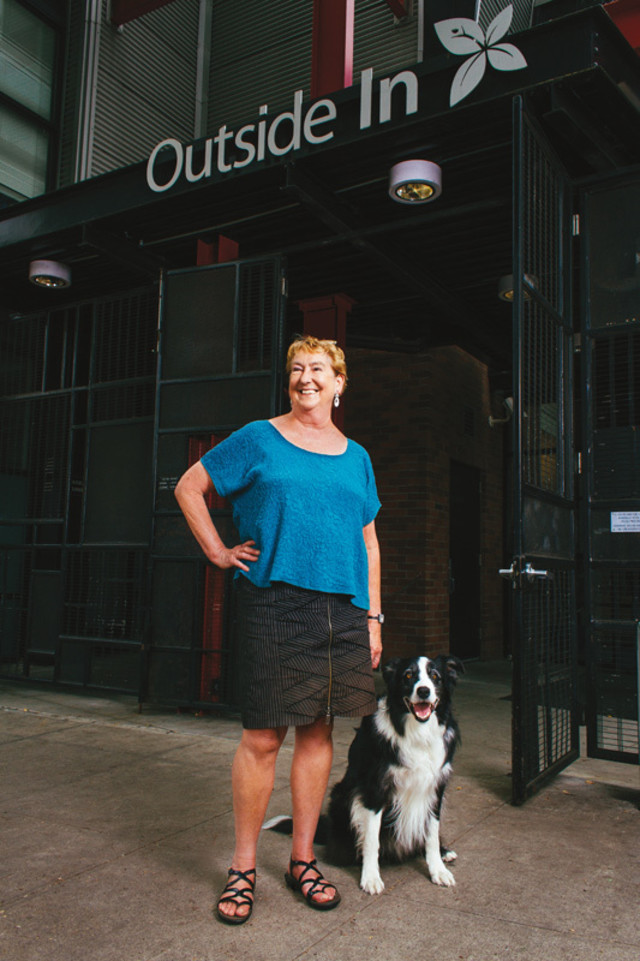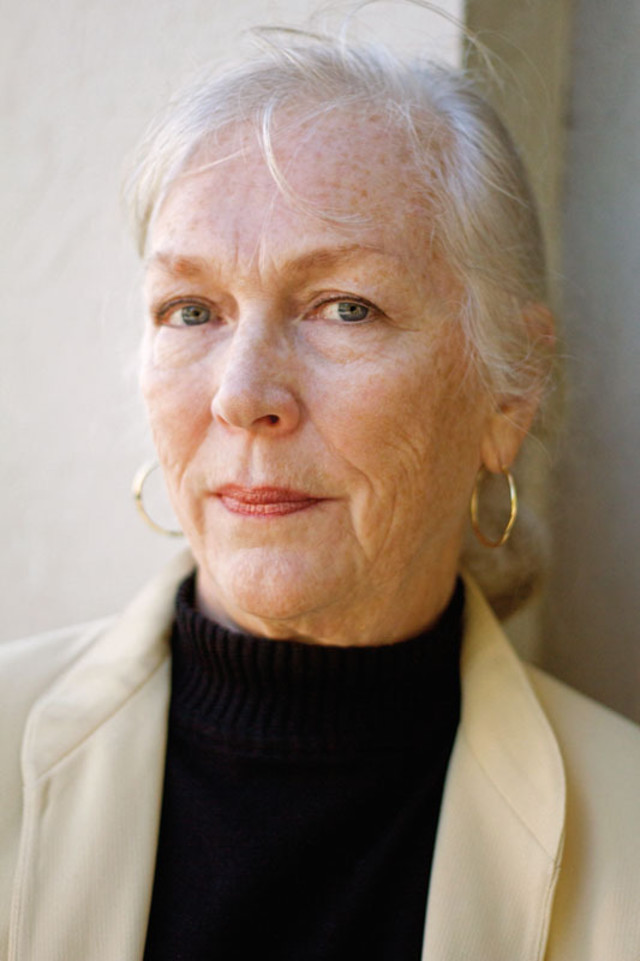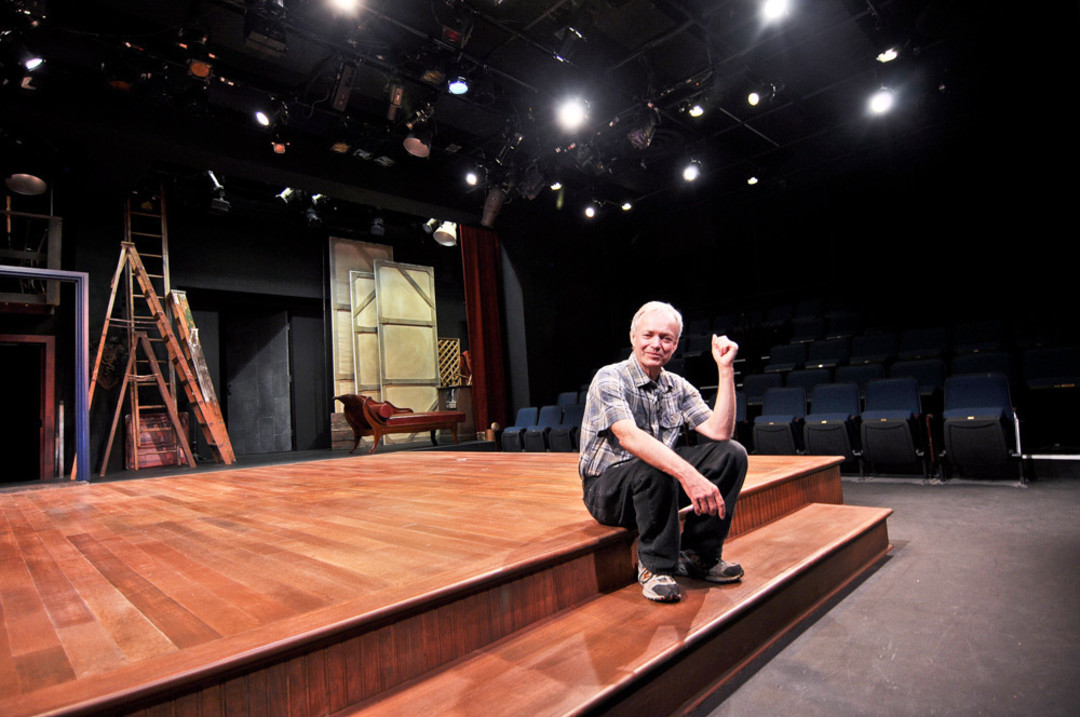Lifetime Achievement
2014: Kathy Oliver of Outside In
Kathy Oliver is uninterested in praise. Ask the long-serving executive director of Outside In about the organization’s extraordinary growth over 46 years, and the demure 65-year-old quickly diverts attention to her 140 employees, her veteran management team (the newest member has been there 12 years), and, most of all, her ceaselessly inspiring clients. Besides, she’s too busy pondering new ways to support Portland’s homeless youth to waste time preening.

Kathy Oliver with her border collie, Zed (Z the Executive Dog)
Image: Ashley Anderson
But Oliver’s powerful maternal role at the core of Outside In, a social services agency for homeless youth and other low-income communities, is hard to miss.
Launched in a coffee shop in 1968, Outside In began as a free, volunteer-supported evening health clinic. Oliver joined in 1981, after earning a PhD in urban and public affairs and spending seven years at the Women’s Crisis Hotline. “I have always believed strongly in social justice,” says the Washington native. “And so I gravitate toward people who don’t have a voice, and who are not getting what they should get.” During her tenure, Outside In’s annual budget has increased to $9 million, and programs have expanded to include free medical care, housing, education, counseling, job training, and more. Over the course of that growth path, the quiet, quirky dog lover has bravely and assuredly steered the ship. “Kathy’s commitment to what can be heartbreaking work has never wavered,” says Kelly Anderson, development director of Outside In. “She is practical yet optimistic, diplomatic yet principled, aggressive yet strategic, innovative yet thoughtful.”
1981: Oliver arrives at Outside In, planning to stay on for two years to shore up its fundraising effort. But she doesn’t leave. “There was something about this agency that just caught me,” she says.
1983: Oliver becomes Outside In’s first executive director and reinforces the organization’s focus on homeless youth. “I just kept thinking, ‘Why are there kids on the streets? Why is that even happening?’ They seemed like such an invisible group to most of the community.”
1989: Oliver pioneers one of the country’s first needle exchange programs, providing sterile syringes in exchange for used ones in an effort to prevent the spread of blood-borne infections, including HIV. “It was probably the hardest thing I’d ever done,” says Oliver of the insurance hurdles and community resistance. Outside In now exchanges about 750,000 syringes annually.
1989: Film director and longtime friend Gus Van Sant employs Outside In clients as extras on My Own Private Idaho. Van Sant has since donated the proceeds from all of his Portland premieres to Outside In.
1992: Oliver and Outside In organize neighbors and businesses in a public stand against Measure 9, a notorious anti-gay-rights ballot initiative, wrapping their entire downtown block with a yellow ribbon and declaring it a hate-free zone. The statewide measure fails. Outside In goes on to develop support groups for LGBTQ homeless youth.
1999: Oliver receives an unmarked letter from the newly formed Bill and Melinda Gates Foundation containing a $1,000,000 check, which funds the construction of an expanded Outside In headquarters on SW 13th Avenue. The building opens in 2001.
2004: Oliver launches Virginia Woof Dog Daycare, a downtown business that also functions as vital job training for homeless youth.
2013: Outside In begins a training and dispensary program for naxolone, a drug used to counter the effects of a heroin overdose. Thus far, the organization has trained more than 800 people.
2014: Oliver starts her second business venture, Bespoke Smoothies, in which homeless youth sell “pedal-powered” smoothies mixed by blenders attached to custom-designed bicycles.
Inspired by our amazing Light a Fire winners? Find out how to give back to
Portland's best nonprofits with our Guide to Giving!
2013: MARY VINTON FOLBERG

Image: Ashley Anderson
“MY FAMILY says that I am the Great White,” says Mary Vinton Folberg, waving her hand like a shark gliding through water, nearly upsetting one of the many piles of papers crowding the desk of her cluttered office at Portland’s Northwest Academy. “I have to keep moving...I have that energy because I feel so strongly about what I do.”
When Folberg moves, the city of Portland is often changed in her wake—for good. Over four decades the McMinnville native has enthusiastically championed the marriage of arts and education, building theaters and cultivating future dancers, writers, and scientists as she goes.
After teaching English and dance in California high schools in the late 1960s, the lifelong performer returned to Oregon to find Portland schools didn’t even have a dance program. She pushed administrators and lawmakers, and, in 1969, she launched the Jefferson High School dance department and then, in 1976, the lauded Jefferson Dancers performance group, whose alums now pepper professional dance companies across the nation. In the early ’80s, as the chair of the mayor-appointed Arts Needs and Use Committee, she helped propose the Newmark and Winningstad Theatres, despite the public’s skepticism that there would be the audience to fill them.
“Mary’s impact is immense,” says McKenzie Kerman, an animator based in Los Angeles who graduated in 2006 from NWA. When a lack of funds barred the then-14-year-old Kerman from attending the school in 2002, Folberg wrangled a four-year, full-ride scholarship for the dyslexic cartoon buff from civic patron Arlene Schnitzer. Some 25 to 30 percent of the academy’s 182 students receive a variety of financial aid. By 1997, the tenacious educator was on the move again. Wanting to develop an art program that was just as rigorous as it was academic, she founded Northwest Academy, her own independent, arts-focused middle and high school housed in an ad hoc quartet of buildings downtown. The private school integrates a very tough academic course load with wildly creative art projects—a place where science students construct comic books about chemical bonding, sixth graders read Kafka, and tap class is mandatory. (It teaches focus and concentration, she says.) Colleges court its savvy grads, and a surprising number of alums end up in the sciences.
“She lives and breathes this school,” says John Thomas, the chairman of NWA’s board of trustees. “She has no ego—it’s all about the kids.”
Next up, Folberg is moving toward a permanent building for the school, which would also house affordable after-school arts classes for any kid who wants them. “It’s just so important to give young people an education that helps them adapt, to enjoy all kinds of people, literature, and art,” she says, practically dancing out of her seat. “That gives them the confidence to follow their dreams.”
2012: ALLEN NAUSE, ARTISTS REPERTORY THEATRE

In his 26-year tenure as Artists Repertory Theatre's artistic director, Allen Nause has added thousands of subscribers and increased the annual budget to $2.5 million.
Image: Mei Ratz
In 1988, when Allen Nause stepped into the spotlight as artistic director of Artists Repertory Theatre, there wasn’t much worth applauding: the company was an ambitious but leaderless entourage of underpaid actors, the theater had 100 annual subscribers at most, and performances were held in the third floor of a building owned by the YWCA. Nause, an actor and director, knew little about running a nonprofit, but it turned out he had a natural aptitude for leadership. He committed to upping the subscriber base to solidify the financial base, and then made a decision to compensate artists for their worth, making Artists Rep the second theater in Portland to enter into a contract with the Actors’ Equity union. Perhaps most presciently, he also vowed never to compromise the theater’s artistic mission: to challenge audiences with adventurous, provocative plays, especially new works and radically reimagined takes on classics (productions include TopDog/Underdog, Death of a Salesman, and Blackbird). A quarter-century later, Nause has built a loyal following of audience-believers whose high expectations of the theater match his own. The longest-running theater company in Portland, Artists Rep now boasts some 4,000 subscribers, an annual budget of $2.5 million, and its very own building, jauntily painted red, on SW Morrison Street. It has not one but two intimate theater spaces. Nause will retire next summer, but he remains as committed to mounting challenging work as ever. “The biggest mistake a company can make is to ask, ‘What does the audience want?’” he says. “Instead you should always ask, ‘What do we believe in?’”
2011: Linda Huddle
Linda Huddle’s retirement from her post as director of Portland Community College’s Alternative Programs marked the end of a 40-year-career as one of Portland’s most effective advocates for at-risk youth. “These are kids who want the best for themselves and their families but don’t have the right doors available to them,” she says. “Our role as teachers is to open those doors and help them step through and succeed.” Huddle began her extraordinary career as a Spanish teacher at West Linn High in the ’60s. She spent nine years as the youth program manager for the Private Industry Council, which afforded job-training programs to some of Portland’s hardest-to-reach youth. She joined the board for Open Meadow, a nontraditional school in North Portland for struggling students, and was a founding board member of the Youth Employment Institute, which offers everything from gang prevention services to GED classes. In 2000, she became the director of PCC Prep Alternative Programs, allowing her to improve programs to steer troubled students toward completing high school and into college or employment. In that capacity, she codeveloped the Gateway to College program, which helps high school dropouts fulfill collegiate dreams by letting them achieve a high school diploma while earning college credit. The program has expanded into 16 states—and, to 100 school districts—thanks in part to an initial $4.8 million grant from the Gates Foundation. “Coming to PCC allowed Linda to bring her previous experiences together to create something really big,” says Pamela Blumenthal, interim director of PCC Prep Alternative Programs. “She’s an absolute visionary.”
2010: SALLY MCCRACKEN
When Sally McCracken graduated from college in 1950, World War II vets were returning to the workforce and women were returning to the home. “But my husband understood that I’d go nuts,” says the 86-year-old, chuckling. “So he told me, ‘If there’s anything you want to do, go do it.’” And so began her career as a volunteer spark plug in the engines of Portland’s nonprofit world. In 1979, after serving as the board chair for Impact Northwest and the committee chair for Emergency Helping Agencies Committee, McCracken helped to found Central City Concern (CCC), an ambitious nonprofit with the initial goal of improving local treatment options for chronic alcoholics. During her seven-year tenure as board chair, McCracken helped increase CCC’s portfolio of affordable urban housing units and expanded the organization’s recovery programs to include treatment for drug addiction. The nonprofit now owns and/or manages more than 1,500 units of housing in 23 buildings throughout the metropolitan area, providing social services including health care, rehabilitation, and employment to 13,000 homeless and very low-income Portlanders each year. In 1991, CCC officially named its landmark headquarters at NW Sixth Avenue and Everett Street (that also contains 106 drug-and-alcohol-free units) the Sally McCracken Building. There’s more. From 1984 to 1995, McCracken sat on the board of the Oregon Community Foundation (OCF), overseeing a quintupling of its endowment. For five years, she also served as the founding chair of OCF’s Giving in Oregon Council and traveled all over the state promoting philanthropy. “Beloved by people of all ages, she imbues community service with so much joy that people want to come back for more,” says OCF president Greg Chaille. She’s also too modest to fess up to her myriad accomplishments. “I can say that I haven’t wasted my life,” McCracken concedes. “But I don’t play bridge, tennis, or golf, so what else would I be doing?”




